Papers by Susana Muñoz Hernández
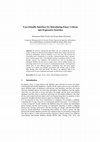
Advances in Intelligent Systems and Computing, 2019
We present a framework that allows any user (without the need of neither technical no theoretical... more We present a framework that allows any user (without the need of neither technical no theoretical knowledge) to define fuzzy criteria based on the non-fuzzy information stored in databases in an easy way. The interests for developing such a framework is to provide a human-oriented (fuzzy and nonfuzzy) search engine with a user-friendly interface to perform expressive and flexible searches over databases. We achieved this task by providing an intelligent interface for the users to define fuzzy criteria without having any knowledge about its low-level syntax or implementation details. Our framework allows users to pose different queries (combining crisp and fuzzy search criteria) over various conventional and modern data formats such as JSON, SQL, Prolog, CSV, XLS and XLSX. We believe our approach adds to the advancement for more intelligent and human-oriented fuzzy search engines.
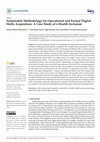
Sustainability, 2021
This study explains the rationale of a methodology developed by the Universidad Politécnica of Ma... more This study explains the rationale of a methodology developed by the Universidad Politécnica of Madrid (UPM) group TechPeopleCare as applied to the e-Health Inclusion through ICT Training project partly funded by the European Institute of Technology EIT-Health in 2019. An initial sample of 168 participants with different lifestyles and migrant backgrounds, with high female participation, were recruited in three different countries by three different organisations following strict ethical protocols that limit the data that can be shared. The learning materials were aimed at people lacking the operational and formal skills to use digital media, for example, using a mouse, a keyboard, and navigating the Internet. This learning would enable these cohorts to become beneficiaries of e-Health interventions, such as making a doctor’s appointment, accessing a health record, finding the location of a health centre or the nearest open pharmacy. By the end of the training programme, we found tha...
Joint Conf. on Declarative Programming: APPIA-GULP-PRODE, 2002
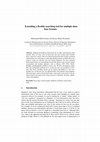
Lecture Notes in Electrical Engineering, 2019
Although all databases frameworks let us make conventional (crisp) searches, there are only a few... more Although all databases frameworks let us make conventional (crisp) searches, there are only a few of them that take into account some flexible, fuzzy, expressive criteria. The few of them that provide some of these searching characteristics are restricted to a particular database format, as FleSe that is devoted to search in a flexible way over Prolog databases. We have extended FleSe framework by an extraordinary feature that allows users to query various conventional and modern databases such as Prolog, CSV, XLS, XLSX, MySQL, and MongoDB or JSON in a fuzzy way. We have developed an adaptable and configurable platform for it so that any user can personalize at run-time. The fuzzy searching criteria can be created and added in a very user-friendly way, so that any user can upload his/her conventional (crisp) database, define the fuzzy search criteria that he/she is interested in and search at the database flexibly and expressively using concepts as similarity, fuzziness, qualificati...
International Journal of Computational Intelligence Systems, 2014
In this work we present the first stage of a two-stage approach for designing rapid transit netwo... more In this work we present the first stage of a two-stage approach for designing rapid transit networks, where the stations and links to be constructed are selected by solving an integer linear optimization model that maximizes an estimation of the number of trips through the rapid transit network. It is based on the first stage of another approach that we described elsewhere. Instead of considering a static origin-destination matrix, we propose a novel way of computing the expected number of trips by making use of the results from a survey amongst the potential users of the rapid transit network. We also report some computational experiments on several randomly generated instances. In the second stage of the approach, a set of lines is generated for the rapid transit network.
Proceedings of the International Joint Conference on Computational Intelligence, 2009
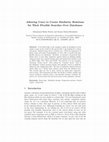
A bi-valued logic is not enough to make an intelligent search engine to give us the result for th... more A bi-valued logic is not enough to make an intelligent search engine to give us the result for the queries like “I am looking for a cheap restaurant, Mediterranean food or similar type”. With the integration of Fuzzy Logic and Logic Programming, we were able to model and pose flexible queries over databases. Therefore, we present a framework that allows users to pose their expressive queries based on defining similar relation criteria over various modern and conventional data formats such as JSON, SQL, CSV, XLS, and XLSX. The interest is in, for example, obtaining “drama movie” when asking for “romantic movie” (only if the similarity relation between drama and romantic movie is explicitly defined in the configuration file). The uses of similarity relation between values allow us to obtain more answers apart from the identical one. The searches that use two or more criteria are much more expressive and accurate. This framework provides the facility to define, modify and remove simila...
Resumen. Web-based applications to assemble web resources, like Yahoo Pipes or Netvibes, are emer... more Resumen. Web-based applications to assemble web resources, like Yahoo Pipes or Netvibes, are emerging as a basis for a new wave of Internet applications that bring semantic web to the general public. Nevertheless, technologies and conceptual tools that allow ordinary users to combine application functionality are immature. There are some formal models but most of them are ontologies that do not capture the complex semantics behind resource composition and resource functionality. In this work we present a formal semantics, in the form of an ontology, to represent resources, composition of resources and resources in execution. Our semantics offers a framework for building tools that assist users to discover resources and connecting them depending on their functionality and their data types they share.
Proceedings of the 5th International Joint Conference on Computational Intelligence, 2013
We present a framework for merging the non-fuzzy real-world information stored in databases with ... more We present a framework for merging the non-fuzzy real-world information stored in databases with the fuzzy knowledge that we (human beings) have. The interest in this aggregation is providing a (fuzzy and non-fuzzy) search engine able to answer flexible and expressive queries without sacrificing a friendly user interface. We achieve this task by using a new syntax (whose semantics are included too) for modelling the domain knowledge and a flexible and enough general structure to represent any user query. We expect this work contributes to the development of more human-oriented fuzzy search engines.

Studies in Computational Intelligence, 2012
Any realistic approach to automatic program parallelization must take into account practical issu... more Any realistic approach to automatic program parallelization must take into account practical issues related to the resource usage of parallel executions, such as the overheads associated with parallel tasks creation, migration of tasks to remote processors, and communication. The aim of granularity control techniques is avoiding such overheads undermining the benefits of parallel executions. For example, sufficient conditions have been proposed to ensure that the parallel execution of some given tasks will not take longer than their corresponding sequential execution. However, when the goal is to optimize the average execution time of several runs, such conditions can be very conservative, causing a loss in parallelization opportunities. To solve this problem, we have proposed novel conditions based on fuzzy logic and performed an experimental assessment with real programs. The results show that such conditions select the optimal type of execution in most cases and behave much better than the conservative conditions.

Incomplete information is a problem in many as- pects of actual environments. In many sceneries t... more Incomplete information is a problem in many as- pects of actual environments. In many sceneries the knowledge is not represented in a crisp way. It is common to nd fuzzy concepts or problems with some level of uncertainty. It is dicult to nd practical systems which handle fuzziness and uncertainty and the few examples that we can nd are minority. To extend a popular system (which many of programmers are using) with this habil- ity seems to be an interesting issue. Our rst work (Fuzzy Prolog (1)) was a language that modelsB((0; 1))-valued Fuzzy Logic. In the Borel Algebra,B((0; 1)), truth value is represented using unions of intervals of real numbers. It sub- sumed former approaches because it was more general in truth value representation and prop- agation than them. Now, we enhance our former approach by using default knowledge to represent incomplete infor- mation in Logic Programming. We also provide the implementation of this new framework. This new release of Fuzzy Prolog handl...

Lecture Notes in Computer Science
In this article we describe a methodology, and its evaluation, for achieving technical competence... more In this article we describe a methodology, and its evaluation, for achieving technical competence through digital literacy training using self-learning training material. The key component is self-learning in the sense that the targeted population learns digital operational skills without the need of a teacher. This is achieved through the adaptation of the training material to the trained group. As training groups are diverse, e.g., including both populations in developing and developed countries, and varying in age aspects, gender, languages, literacy levels and technological literacy levels, materials and the speed which training takes place has to be adapted to take into account these differences. The methodology involves use of training videos, and use a dual screen approach where training material is shown on one screen and training takes place on a second screen (computer). The approach has been evaluated in both developing countries and developed countries, with training groups of different capabilities and backgrounds (in Kenya, El Salvador, Spain, France and The Netherlands), with promising results.
Communications in Computer and Information Science, 2014
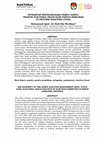
Research and Reviews, 2019
Badan Penyelenggara Pemilu Adhoc atau Panitia Pemilihan adalah penyelenggara pemilu yang paling r... more Badan Penyelenggara Pemilu Adhoc atau Panitia Pemilihan adalah penyelenggara pemilu yang paling rentan menjadi pelaku kecurangan pemilu (election fraud). Anggota PPK, PPS dan KPPS memiliki akses untuk bersentuhan langsung dengan peserta pemilu dan alat kebutuhan pelaksanaan pemilu, mulai dari TPS hingga surat suara. Berdasarkan Peraturan KPU Nomor 8 Tahun 2019 yang memberikan wewenang langsung kepada KPU Kabupaten/Kota untuk menindak dugaan pelanggaran yang dilakukan oleh Panitia Pemilihan, terdapat 239 anggota PPK, PPS dan KPPS yang telah diberhentikan tetap karena terbukti melakukan pelanggaran kode etik, kode perilaku, sumpah/janji dan pakta integritas. Provinsi Sumatera Utara merupakan daerah yang paling banyak melakukan pemeriksaan dugaan pelanggaran integritas oleh Panitia Pemilihan. Pelanggaran yang dilakukan terdiri dari pelanggaran administrasi, malpraktik pemilu hingga tindak pidana pemilu seperti manipulasi pencoblosan surat suara, penggelembungan hasil perolehan suara hingga praktik suap yang terungkap di pemeriksaan Panitia Pemilihan. Permasalahan integritas menjadi persoalan utama dalam evaluasi pelaksanaan pemilu serentak 2019 dari sudut pandang electoral integrity, tingkat integritas penyelenggara pemilu pada tahun 2019 menjadi hal krusial untuk perbaikan format kepemiluan di masa mendatang.

Journal of Refugee Studies, 2021
More than 26 million people are recognized globally as refugees and have been forced to flee from... more More than 26 million people are recognized globally as refugees and have been forced to flee from their home countries because of poverty, human rights violations, natural disasters, climate change, and other social and political conflicts. What is more, most host communities are usually poor and face social and economic crises. This is why supporting integration between refugees and host communities is imperative at the global humanitarian context. Thereby, this research presents the NAUTIA (Need Assessment under a Technological Interdisciplinary Approach) methodology, an innovative mixed-method approach designed by the Platform on Refugees of the Universidad Politécnica de Madrid. The main objective of NAUTIA is to identify the basic needs of refugees and locals to improve their quality of life through interdisciplinary and inclusive intervention proposals based on technology. The methodology was applied in the permanent Shimelba Refugee Camp (Ethiopia), where energy, shelter, and...
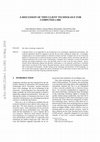
Computer literacy is not negotiable for any professional in an increasingly computerised environm... more Computer literacy is not negotiable for any professional in an increasingly computerised environment. Educational institutions should be equipped to provide this new basic training for modern life. Accordingly, computer labs are an essential medium for education in almost any field. Computer labs are one of the most popular IT infrastructures for technical training in primary and secondary schools, universities and other educational institutions all over the world. Unfortunately, a computer lab is expensive, in terms of both initial purchase and annual maintenance costs, and especially when we want to run the latest software. Hence, research efforts addressing computer lab efficiency, performance or cost reduction would have a worldwide repercussion. In response to this concern, this paper presents a survey on thin client technology for computer labs in educational environments. Besides setting out the advantages and drawbacks of this technology, we aim to refute false prejudices ag...
Proc. of the IPMU Conference, 2008

Fuzzy Logic Programming aims at combining the advantages of Logic Programming (such as readabilit... more Fuzzy Logic Programming aims at combining the advantages of Logic Programming (such as readability, conciseness, and a formally well-defined semantics) with the advantages of Fuzzy Logic (representability of imprecise and uncertain knowledge). In this paper, we present the RFuzzy framework for Fuzzy Logic Programming. It has three main advantages compared to other Fuzzy Logic Programming frameworks: RFuzzy provides constructive answers (it responds with direct results instead of constraints), models multi-adjoint logic, and allows the user 1 to combine fuzzy and crisp reasoning in the same program. It provides some extensions such as default values (to represent missing information) and typed predicates. The truth values of predicates are defined via facts, rules, and functions. We describe the implementation of our framework and its operational semantics. RFuzzy has been implemented and is ready for being used.






Uploads
Papers by Susana Muñoz Hernández